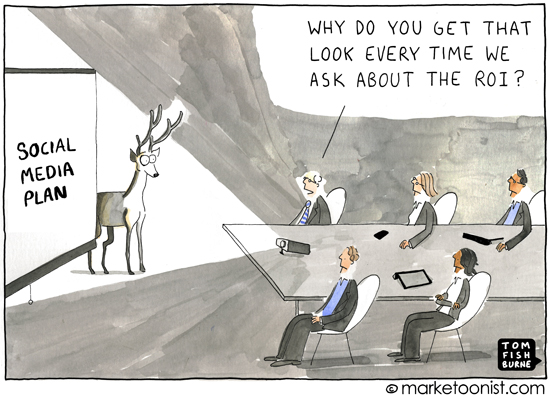In consulting with new clients, I often hear them ask me what the return on investment will be for my recommended marketing approach. I’m going to spend $50,000 – how will we know if it is a good investment?
Of course, this is a reasonable question. In fact, it worries me when clients don’t ask these questions.
Still, I like to ask clients how they calculate the return on investment for other activities like hiring a new salesperson, adding a supervisor in the warehouse, or how they measure the benefit of that fancy new phone system they installed at everyone’s desk.
I like to understand how they measure ROI for other activities so that marketing isn’t singled out with a different standard.
Marketing is different. In some cases, marketing activities must be seen as an investment, not an expense.
Marketing ROI or return on investment often starts by asking a simple math question: if I spend X, what will I get in return for that investment over time. The important idea is overtime, not a one-time transaction.
How will I know that the investment is worthwhile if I spend $10K on sponsorship, $20K advertising, or $30K to attend a trade show?
For marketing, I like to begin by understanding the lifetime value (LTV) of a customer.
If someone buys from me once and never buys again their value to the company is fleeting and transactional. But if someone purchases from me year after year, you can begin to calculate the return on spending versus the CAC – the customer acquisition cost.
Lifetime Value (LTV)
Last year, one of my B2B clients was stumped when I asked them what the lifetime value of their customer is and how they calculate it.
“We never calculated it,” they told me. “We don’t think about it that way.”
We did a little exercise where we looked at ten years of data and found that, on average, a customer was worth $250,000 over five years. They had 443 customers.
How much would you pay for one customer if, over five years, you got $250,000?
They didn’t know because they hadn’t been asked the question this way.
When we calculated the numbers, they realized that if they spend $25,000 to get a typical B2B customer who will purchase $250,000 over five years, that investment provides a solid return for them.
Marketing and Lifetime Value
- If a marketing campaign can get you, one client worth $250K then spending $25K makes sense to acquire that one client makes sense. Do you know your customer acquisition cost math?
- In a B2C e-commerce business, you might have to spend $90 to acquire a new customer. If your products sell for $150-200, will they buy once or is it possible they’ll buy a few times over several years? How can your products remain relevant to the community you serve?
- Often, in B2C, your product value must be high enough to make the customer acquisition cost worthwhile. One of my clients from a few years ago bundled six products together and raised the sale price significantly. They also used a service like www.splitit.com to allow their customers to pay for the products monthly versus at one time.
- Can your products be put into a reoccurring bundle of services/sales versus one-time transactions? A rundle – or reoccurring revenue model might shift your business model to make your business more valuable. Adobe realized that a monthly subscription was worth far more than a one-time purchase of their suite. Scott Galloway, NYU Professor (Prof G) developed this concept. Check out his podcast here.
- If you aren’t nurturing existing customers through a customer success manager, you are leaving money on the table. You already spent money to acquire that customer, are you staying close to them so when opportunities come up, they think of you?
Beyond ROI
An essential factor gets overlooked in measuring a customer’s lifetime value or determining how to measure ROI? How will a customer become more valuable over time? It isn’t just in what they buy, but how they engage with the company and how they help market for you. Will they help amplify your story on their social media channels? Will they write reviews to help you build reputation and gain trust?
Will customers:
- Bring your new ideas and insights?
- Promote you to their friends?
- Do testimonials for your company?
- Share news about your company?
- Allow you to see data to help you understand the value?
- Speak at conferences you sponsor?
- Give you access to non-proprietary research?
Lifetime value is both a simple and complicated topic.
Most companies need to put some rigor around knowing how to segment and value each customer to clear how much should be spent to acquire new customers. Not all customers are equal, so your ROI might be calculated differently depending on the customer’s return beyond revenue.
Start with the simple math of understanding how much a customer might buy over time. Beyond those purchases, the right customers can add enormous value to your business if they are helping you grow, collaborate and innovate for tomorrow.
Photo by Erik Mclean on Unsplash
Marketing Cartoon Courtesy of Tom Fishburne. If you are a marketer, you’ll love Tom’s work. Sign up here for free.





